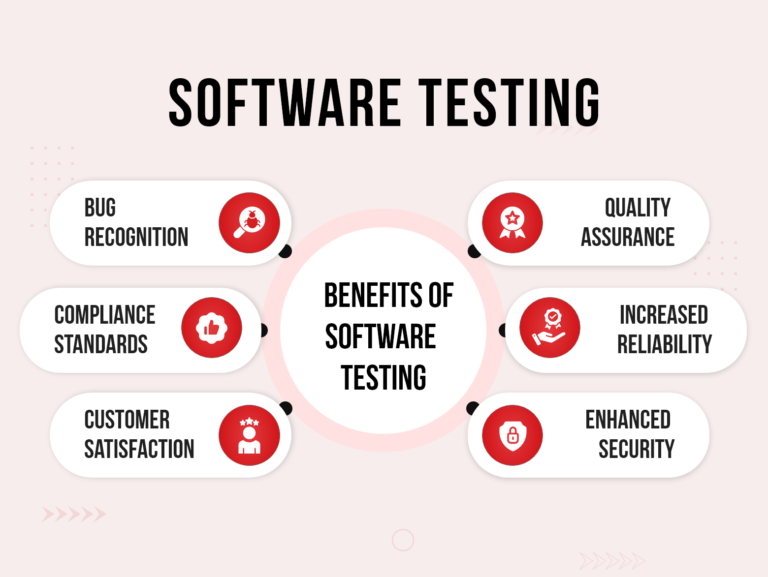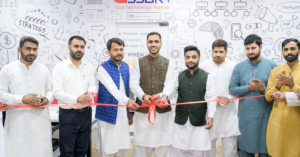Software testing is one of the most important processes in the development of software applications. It is a process of evaluating a software application or system to ensure it meets the desired requirements. The main objective of software testing is to identify software defects, errors, and inconsistencies, enabling developers to fix them and improve the overall application quality. By conducting thorough testing, software development teams can identify and rectify issues early in the development cycle, preventing them from escalating and causing problems for end users.
Testing helps ensure that the software operates reliably, delivers the expected outcomes, and provides a positive user experience. Software testing encompasses various activities, including planning, designing test cases, executing tests, and analyzing results. Testing can be done manually or through automated tools, and it is an essential step in the software development life cycle to ensure that the software is of high quality and meets user expectations. In addition, software testing aims to identify defects early in the development process, so they can be fixed before the software is released to the public. Software testing plays a vital role in delivering high-quality software that meets user expectations, minimizes risks, and enhances customer satisfaction. It is an iterative and ongoing process throughout the software development lifecycle, ensuring that the application is robust, reliable, and performs optimally in real-world scenarios.
Importance of Software Testing
Software testing is an integral part of quality assurance activities within the software development lifecycle. It enables the identification and correction of errors, leading to software that meets user expectations and performs reliably. Testing plays a vital role in software development, serving as a critical mechanism to ensure software applications’ quality, reliability, and performance. Its importance can be defined in the following ways:
Identifying and Fixing Defects:
Testing helps detect defects, bugs, and errors in the software early in the development cycle. By identifying these issues, developers can address them promptly, minimizing the chances of their occurrence in the production environment. This improves software quality and reduces the risk of malfunctions or failures that could negatively impact users.
Ensuring Software Functionality:
Testing verifies that the software meets the specified functional requirements. It validates that the application performs as intended and delivers the expected outputs. By conducting functional testing, developers can ensure that all software features, functions, and interactions work correctly, enhancing its usability and user satisfaction.
Enhancing User Experience:
Effective testing helps identify usability issues, ensuring the software is intuitive, user-friendly, and provides a positive user experience. By addressing usability concerns, such as navigation difficulties or confusing interfaces, testing contributes to creating software that is easy to use and meets user expectations.
Mitigating Risks:
Testing helps reduce risks associated with software failures, security breaches, and performance issues. It ensures that the software operates reliably and securely, minimizing the likelihood of data loss, system crashes, or unauthorized access. Developers can identify vulnerabilities and bottlenecks by conducting security and performance testing, allowing for necessary improvements to safeguard the software and its users.
Cost and Time Efficiency:
While testing requires time and resources, it ultimately saves cost and time. Testing prevents costly rework and post-production fixes by detecting and fixing issues early. It also contributes to shorter development cycles and faster time-to-market, enabling businesses to gain a competitive edge.
Principles of Testing
There are seven principles of testing, as defined by the ISTQB (International Software Testing Qualifications Board)
Testing Shows the Presence of Defects:
The primary purpose of testing is to uncover defects or errors in the software. Testing helps identify discrepancies between expected and actual outcomes, providing valuable information for quality improvement.
Exhaustive Testing is Impossible:
Testing every possible combination of inputs, states, and conditions within a software system is impossible. Therefore, testing efforts must focus on areas more likely to contain defects and deliver the highest value.
Early Testing:
Testing activities in the software development lifecycle should commence as early as possible. Detecting and resolving defects early reduces the cost and effort required to fix them in later stages and improves overall software quality.
Defect Clustering:
Experience has shown that a few modules or components often contain most defects. By focusing testing efforts on these high-risk areas, testers can maximize their effectiveness and improve defect detection rates.
Pesticide Paradox:
Repeated testing with the same set of test cases will eventually decrease defect detection. To overcome this “pesticide paradox,” test cases must be regularly reviewed, updated, and supplemented with new cases to uncover previously undetected defects.
Testing is Context-Dependent:
The approach and techniques used for testing may vary depending on the context of the project, including the software’s purpose, complexity, and criticality. Testing strategies should be tailored to fit each project’s specific needs and requirements.
Absence-of-Errors Fallacy:
The absence of detected defects does not guarantee the absence of defects or errors in the software. Testing can help provide confidence in the software’s quality but cannot ensure perfection. Additional measures, such as risk analysis and quality assurance activities, are essential for comprehensive software quality management.
Software Testing Approaches
There are several different approaches for software testing, each with its purpose and focus. However, some common approaches to softwares testing include:
Black Box Testing:
Black box testing treats the software as a “black box” and focuses on testing the functionality and behavior of the system without considering its internal structure or implementation. Testers only have access to the input and output of the system and do not know its internal workings.
White Box Testing:
White box testing, also known as structural or glass box testing, examines the internal structure and logic of the softwares. Testers can access the source code and use their knowledge of the system’s internals to design tests that exercise specific paths and conditions within the code.
Grey Box Testing:
Grey box testing involves the combination of both white box and black box testing. Testers have partial knowledge of the internal workings of the software, such as high-level design or limited access to code. This approach allows for a more targeted and comprehensive testing strategy.
Manual Testing:
Manual testing involves the execution of test cases by human testers without using automation tools. Testers manually perform the tests, observe the software’s behaviour, and validate its correctness against expected results. Manual testing allows for flexibility and human judgment in exploring different scenarios.
Automated Testing: Automated testing involves using specialized tools and scripts to execute tests, compare actual outcomes with expected results, and generate test reports. It improves testing efficiency, repeatability, and coverage, especially for repetitive or large-scale testing efforts.
Agile Testing:
Agile testing aligns with the principles of Agile software development methodologies. It emphasizes continuous testing throughout the development lifecycle, early and frequent feedback, collaboration between testers and developers, and adapting testing strategies based on changing requirements.
Risk-Based Testing:
Risk-based testing involves prioritizing testing efforts based on the identified risks associated with the software system. Testers assess the potential impact and likelihood of risks and allocate testing resources to focus on areas with higher risks.
Model-Based Testing:
Model-based testing utilizes models or representations of the system’s behavior, requirements, or design to generate test cases automatically. These models serve as a basis for generating test inputs and expected outputs, reducing manual effort and improving test coverage.
Usability Testing:
Usability testing evaluates the software’s user interface, user experience, and ease of use. Testers assess how well users interact with the system, understand its features, and accomplish tasks efficiently.
Benefits of Software Testing
Software testing offers several benefits throughout the software development lifecycle. It is vital in mitigating risks, improving software quality, and delivering reliable and user-friendly applications. Furthermore, It helps organizations build confidence in their software products and ensures a positive experience for end-users.
Here are some key Advantages of Software Testing:
Bug Recognition:
Testing helps identify software defects, bugs, and errors. By detecting and addressing these issues early in the development process, testing helps prevent larger problems. It improves the overall quality of the software, and ensures that the application is free from bugs, glitches, and defects.
Quality Assurance:
Testing ensures that the software meets the desired quality standards and meets specified requirements. It helps validate that the software functions as expected, delivers the intended features, and performs reliably.
Increased Reliability:
Testing helps improve the reliability and stability of the softwares. Uncovering and resolving defects reduces the likelihood of system crashes, failures, and unexpected behaviour, thus improving the overall reliability of the software.
Enhanced Security:
Testing includes security testing, which helps identify vulnerabilities, weaknesses, and potential security breaches in the software. By addressing these issues, testing helps enhance the security and integrity of the software, protecting sensitive data and minimizing risks.
Compliance and Standards:
Testing ensures the software complies with industry standards, regulations, and guidelines. It helps verify that the software meets legal requirements, accessibility standards, privacy regulations, and other applicable criteria.
Customer Satisfaction:
Reliable and high-quality softwares that has undergone thorough testing will likely meet customer expectations. By delivering software that functions as intended, testing helps enhance customer satisfaction and trust in the product.
Conclusion
In conclusion, software testing is an indispensable aspect of software development that plays a crucial role in ensuring software applications’ quality, reliability, and success. Through rigorous testing methodologies and techniques, developers can identify and rectify defects, bugs, and vulnerabilities, thus enhancing the overall performance and functionality of the software. Organizations can minimize the risk of software failures, crashes, and security breaches by conducting thorough testing. Early detection and resolution of issues during testing led to substantial cost savings by reducing rework, customer support, and potential financial losses.
Moreover, software testing is essential for meeting regulatory standards and industry best practices, ensuring compliance and reliability. By adhering to these standards, organizations demonstrate their commitment to delivering high-quality software that meets user expectations and provides a positive user experience. The benefits of software testing extend beyond internal processes and impact the organization’s reputation and customer satisfaction. Organizations can build customer trust, enhance their reputation, and gain a competitive edge by delivering bug-free, reliable software. Software testing remains a critical discipline in a rapidly evolving technological landscape, where software applications are becoming increasingly complex. It empowers organizations to deliver robust and efficient software solutions that meet users’ needs and exceed their expectations.










